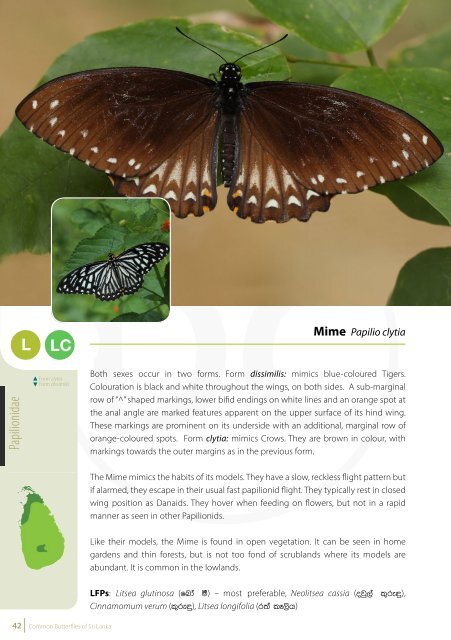Common Butterflies of Sri Lanka
Common Butterflies of Sri Lanka
Common Butterflies of Sri Lanka
Create successful ePaper yourself
Turn your PDF publications into a flip-book with our unique Google optimized e-Paper software.
L<br />
LC<br />
Mime Papilio clytia<br />
Blue Bottle Graphium sarpedon<br />
M<br />
LC<br />
Papilionidae<br />
Form clytia<br />
Form dissimilis<br />
Both sexes occur in two forms. Form dissimilis: mimics blue-coloured Tigers.<br />
Colouration is black and white throughout the wings, on both sides. A sub-marginal<br />
row <strong>of</strong> “^” shaped markings, lower bifid endings on white lines and an orange spot at<br />
the anal angle are marked features apparent on the upper surface <strong>of</strong> its hind wing.<br />
These markings are prominent on its underside with an additional, marginal row <strong>of</strong><br />
orange-coloured spots. Form clytia: mimics Crows. They are brown in colour, with<br />
markings towards the outer margins as in the previous form.<br />
The sexes are similar. It has a narrow forewing and a serrated outer margin on its hind<br />
wing which extends into a short tail at the tornus. The upper surface <strong>of</strong> its wings is<br />
blackish brown with a median blue band divided into rectangular patches by black<br />
veins. The patches towards the forewing apex have a greenish tinge. A sub-marginal<br />
band <strong>of</strong> crescent shaped patches are present on its hind wing. Blue markings are<br />
visible in a similar manner on its underside, on a chocolate brown background with<br />
additional red patches on the hind wing.<br />
Papilionidae<br />
The Mime mimics the habits <strong>of</strong> its models. They have a slow, reckless flight pattern but<br />
if alarmed, they escape in their usual fast papilionid flight. They typically rest in closed<br />
wing position as Danaids. They hover when feeding on flowers, but not in a rapid<br />
manner as seen in other Papilionids.<br />
The Blue Bottle is a very fast flier who regularly flies at canopy level in low forests. It visits<br />
canopy flowers and sometimes descends to shrubs like Hedyotis fruticosa (jerKsh). It<br />
is rapid even at feeding, quickly jumping from flower to flower and returning to the<br />
same one again. It is regularly seen at hill tops where others are absent due to excess<br />
wind. Males engage in mud puddling, typically alone or in a group <strong>of</strong> 2-3.<br />
Like their models, the Mime is found in open vegetation. It can be seen in home<br />
gardens and thin forests, but is not too fond <strong>of</strong> scrublands where its models are<br />
abundant. It is common in the lowlands.<br />
It is commonly found in damp, densely wooded areas in the wet zone. It is occasionally<br />
found in the dry zone, but always in wet habitats, and especially in the rainy season.<br />
42 <strong>Common</strong> <strong>Butterflies</strong> <strong>of</strong> <strong>Sri</strong> <strong>Lanka</strong><br />
LFPs: Litsea glutinosa (fnda ó) – most preferable, Neolitsea cassia (ojq,a l=re÷),<br />
Cinnamomum verum (l=re÷), Litsea longifolia (r;a lE,sh)<br />
LFPs: Neolitsea cassia (ojq,a<br />
stenophylla (ksl ojq,)<br />
l=re÷q), Cinnamomum verum (l=re÷), Actinodaphne<br />
<strong>Common</strong> <strong>Butterflies</strong> <strong>of</strong> <strong>Sri</strong> <strong>Lanka</strong> 43















